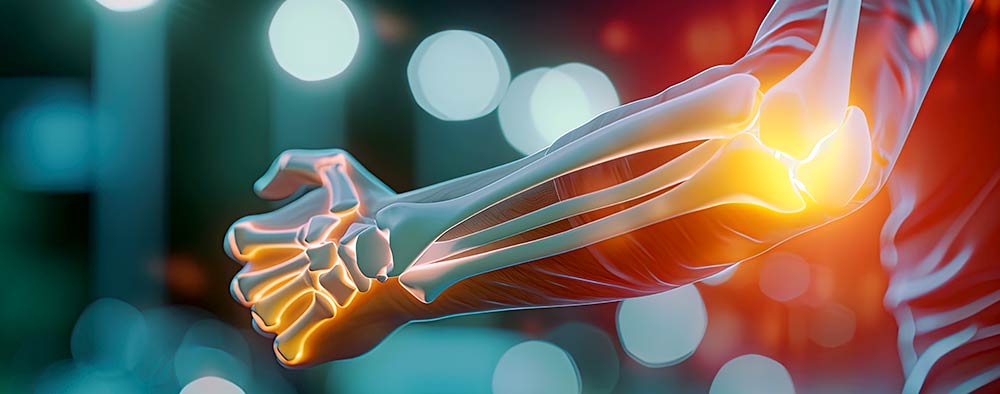by Brent Hearn •
The human body is a mind-bogglingly complex machine. The way its many components (usually) work together in harmony to keep us breathing, thinking, and living is a marvelous thing to behold.
The human body is also pretty weird. These meat sacks we call “us” are a gold mine of trivia just waiting to be discovered and discussed. Since this is a chiropractic blog, it’s worth noting a few things about bones and joints that you can use at an icebreaker at the next party when you’ve exhausted your Marvel and T-Swift knowledge.
Not all humans have 206 bones.
It’s one of those nuggets of trivia you likely learned as a child and proudly recited to show how smart you were: There are 206 bones in the human body. But it would have been more accurate to say that most adult humans have 206 bones. Or that a human adult has about 206 bones.
Why the equivocation? Well, when we’re born, we can have closer to 300 bones! As we grow, some of our bones fuse, leaving most of us with that precious 206 number we all know and love. But adults can have more bones; some of us have extra digits, vertebrae, or ribs.
No one is actually double-jointed.
Have you ever met someone who could contort their fingers at a stomach-churning angle that, for most other people, would require a trip to the emergency room? Or someone who could drop into full side splits with zero training and no preparation? If so, there’s a good chance that when met with an astonished, “How did you do that?!” they shrugged and responded, “It’s easy. I’m double-jointed.”
If so, that person was lying.
Okay, perhaps “lying” is a bit harsh. It’s possible that some of us are still carrying a grudge from the week’s worth of lunch money we lost when a kid bet they could bend their thumb to their wrist without having to call an ambulance. Perhaps it’s more accurate to say they’re simply mistaken.
What so many of us call “double-jointed” is actually something called hypermobility, which is a fancy term for the ability to move one’s joints further than most of us can without any special training. (If, say, you’re a dancer, gymnast, or martial artist who’s trained hard to achieve a high level of flexibility, that’s not what we’re talking about; this kind of hypermobility is something you’re born with.)
Hypermobility can be caused by a variety of factors, including abnormal collagen or elastin fibers, shallow bones in your joint sockets, and, in some cases, more serious medical conditions.
The smallest bone in your body.
It’s quite possible you already know that the femur is the longest bone in your body. (Another popular trivia question.) But have you “heard” what the shortest bone is?
As you may have guessed from that super-lame hint, it’s in your ear. The stapes, one of the three bones collectively known as ossicles (the other two are the malleus and the incus), resides in your middle ear. The stapes helps to transfer sound vibrations from the external environment to the inner ear, and it’s smaller than one kernel of short-grain rice!
If you think one or more of the bones and joints in your miraculous body may need some attention, make an appointment with a chiropractor.
In the meantime, we hope you’ve learned a little something today. Just be sure you impart your newfound wisdom from a place of wonder rather than condescension. There’s a fine line between being the most interesting person in the room and being the person people dodge on their way to the snack table.
Sources:
BBC: The Myth of Being Double-Jointed
Cleveland Clinic: 13 Strange and Interesting Facts About Your Bones
healthline: Stapes
StatPearls: Anatomy, Head and Neck, Ear Ossicles
Think Rice: Rice Types and Forms
USA Today: Humans Have Nearly 100 More Bones at Birth Than as Adults
verywell health: Can You Really Be Double-Jointed?









 ▶︎
▶︎  Why is the Discount Challenge prize amount $15,024? Because that is the average “per-occurrence” fine for Medicare inducements. That’s not $15,024 per patient, that’s not per provider, that’s PER VISIT. Stinks, doesn’t it? To us, the prize amount is worth the investment if we can help our profession better understand proper discounting.
Why is the Discount Challenge prize amount $15,024? Because that is the average “per-occurrence” fine for Medicare inducements. That’s not $15,024 per patient, that’s not per provider, that’s PER VISIT. Stinks, doesn’t it? To us, the prize amount is worth the investment if we can help our profession better understand proper discounting.